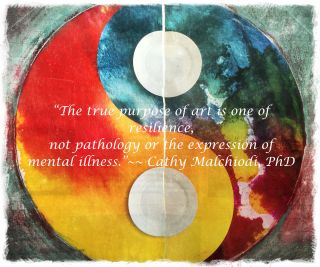Resilience
Art is about Resilience, It Always Has Been
Art therapy is and always has been a resilience-building approach.
Posted August 31, 2015

Resilience is a current hot topic in the field of art therapy, with many practitioners bending the traditional psychoanalytic foundations of the field toward a less pathology-driven framework. In contrast, most of the historic literature that makes up the early foundations of art therapy as a domain originates from practitioners who were educated in psychodynamics and, as a result, generally wrote about art expressions with an emphasis on the language of defense mechanisms of the time period. For example, client-created art expressions that approximate visual imagery found in earlier stages of artistic development are labeled “regressed;” the term “projection” is used to describe expressive content that is created without conscious insight; and “sublimation” defines both the art product and process as a channeling of less desirable impulses, cognitions or emotions into creative expressions (drawings, paintings, sculptures, etc) that are acceptable forms of visual imagination. These descriptors are still found in present day art therapy theory and practice; even the most humanistic and cognitive-behavioral art therapists continue to apply these psychodynamic terms in defining visual content and creative process that unfolds during therapy.
Decades ago as a graduate student I found these descriptors troubling and incomplete in describing what I felt about art therapy and expressive arts therapies; in fact, I found the writings of art therapy practitioners at odds with my own personal understanding as an artist because they seem to dismiss what I felt was the true purpose of art expression. For me, that true purpose of art is one of resilience, not of pathology or mental illness. It is why humankind has continually returned to art making as one way to reparation and recovery from the inescapable physical, emotional, interpersonal and spiritual challenges of life. In other words, art expression and the creative process are really manifestations of the drive toward health and well-being, not merely signposts of repression, projection, displacement, and even the more “mature” defense mechanisms of sublimation and compensation. As Louise Bourgeois noted, “Art is a guarantee of sanity” – it a human way of self-actualizing rather than pathologizing the potential of one’s life.
The resilience-enhancing capacities of art expression are not found in any one particular art-based activity, but within the characteristics of art making itself and also the relational dynamics between the individual and therapist. Here is some of the current evidence on just how art expression and art therapy enhances and supports resilience in people of all ages:
Quality of Life. A growing number of studies underscore how art therapy increases the perception of quality of life including individuals with cancer, dementias, and other challenges; perception of quality of life is a central component of personal resilience, despite physical health or psychosocial challenges.
Affect-Regulation. Art making can be a self-regulating practice and one that draws upon an “effort-driven rewards system” to mediate mood, particularly anxiety and depression. Art therapy research is beginning to identify just how and why this mediation occurs, including some preliminary neuroscience-informed data on what actually happens in the brain and body during creative arts experiences. Studies also highlight that under certain circumstances viewing great works of art brings about a chemical cascade similar to the sensation of “falling in love.”
Mastery. The experience of mastery is found through a variety of action-oriented experiences and builds confidence not only in specific skills, but also in the larger realm of personal efficacy. The sensory-based, action-oriented qualities of art expression, whether drawing, painting, sculpting, assembling, constructing or crafting, naturally support capability, competency and personal strengths. Creative endeavors are not only self-rewarding, they are also tangible moments of mastery and personal empowerment that enhance an internal locus of control.
Right-Hemisphere to Right-Hemisphere. While art making is a whole brain activity and not limited to one part of the brain, the process of art therapy capitalizes on the right-hemisphere dominance of both creative expression and positive attachment between therapist and individual. The latter is transformative in ways that strictly verbal therapies are not because art therapy involves multiple senses [visual, tactile, kinesthetic and more], combined with specific, targeted interpersonal exchanges between therapist and individual. It is this relational aspect that reinforces resilience as a central outcome of art therapy because it is through connection that not only personal strengths, but also reparation and recovery are often realized.
Ultimately, sharing one’s story and truth is a key factor not only in recovery, but also in the realization of personal strength and efficacy. Art expression is one way to communicate narratives without words; in many cases, it becomes the opportunity to tell one’s story without the parameters, restrictions and judgments of language. It is this core experience found in creative endeavors that tells us art’s purpose is not merely to exemplify internal conflicts, but is actually to provide a way to continuously reinforce our own self-empowering, life-affirming capacity for resilience.
Be well and be resilient,
Cathy Malchiodi, PhD, LPCC, LPAT, ATR-BC, REAT
©2015 Cathy Malchiodi, PhD
For more information, please see:
Malchiodi, C. (2015). Calm, connection and confidence: Using art therapy to enhance resilience in traumatized children. In D. Crenshaw et al (Eds.), Play Therapy Interventions to Enhance Resilience (pp. 126-145). New York: Guilford Publications.
And yes, you can quote this article as follows:
Malchiodi, C. (2015, August 31). Art is about resilience, it always has been. Retrieved August 31, 2015, from https://www.psychologytoday.com/blog/arts-and-health/201508/art-is-abou….
For more information on art therapy and related topics, go to the following Facebook pages:
Public pages at https://www.facebook.com/cathy.malchiodi and https://www.facebook.com/cathymalchiodiphd.
Trauma-Informed Practices & Expressive Arts Therapy Institute for continuing education courses and a variety of resources, articles and links at https://www.facebook.com/pages/Trauma-Informed-Practice/155797157835392.
Or visit www.trauma-informedpractice.com or www.cathymalchiodi.com.




